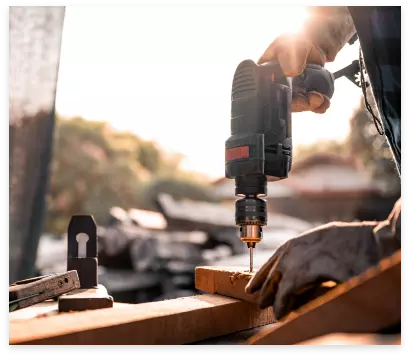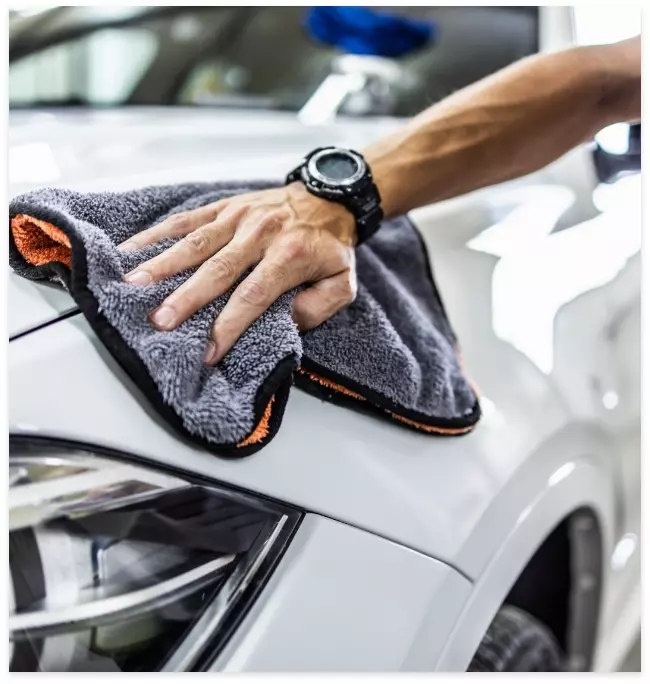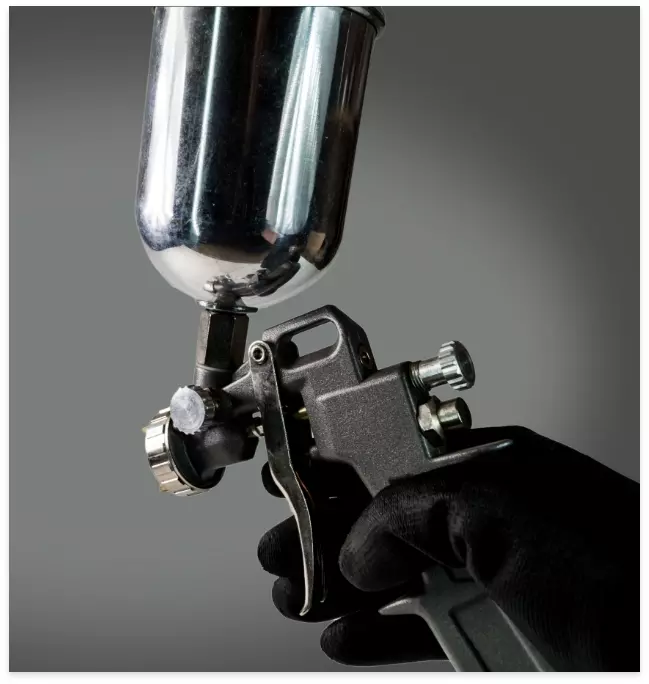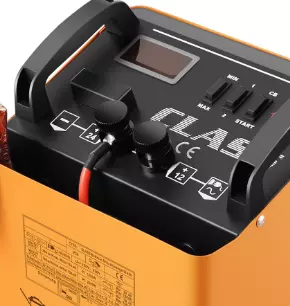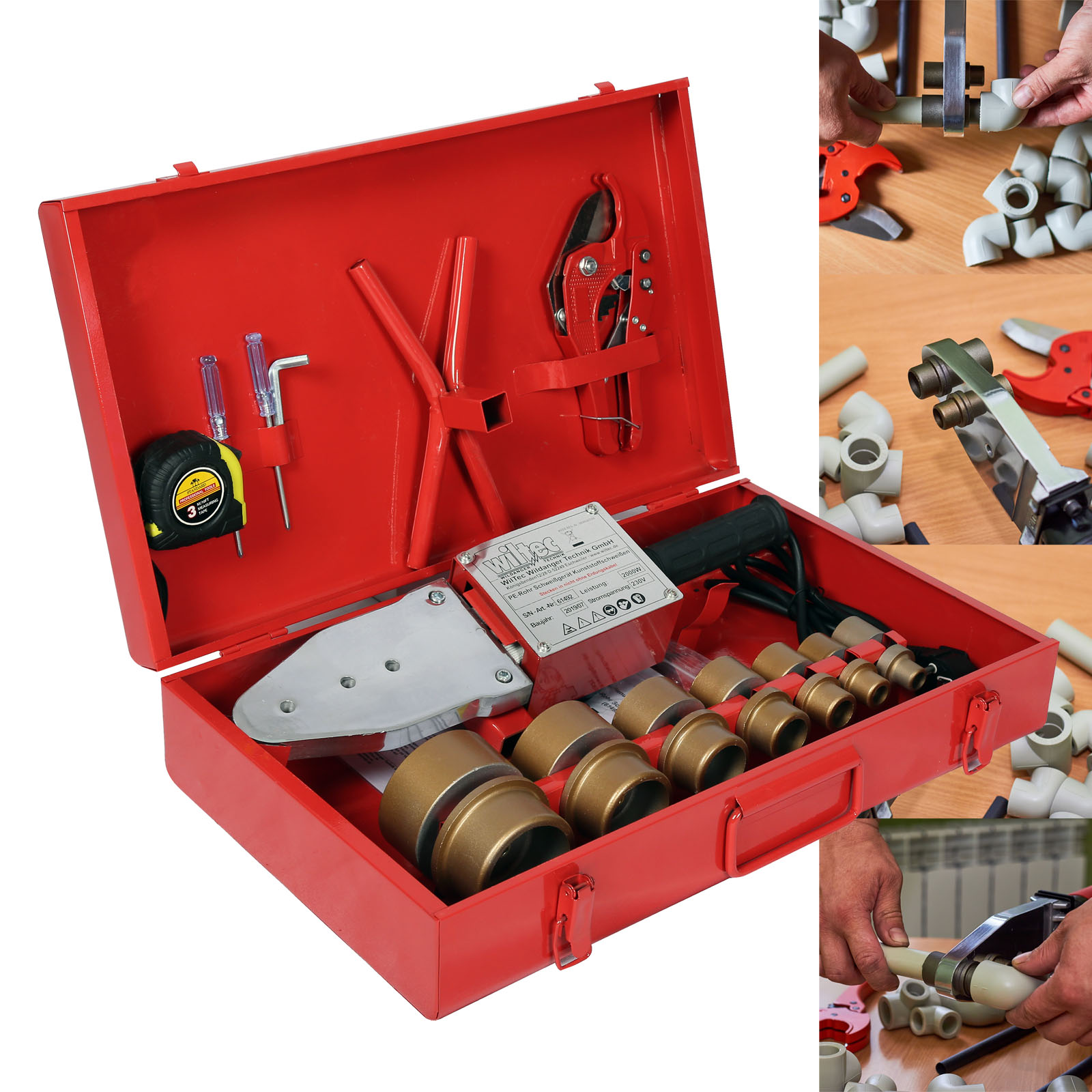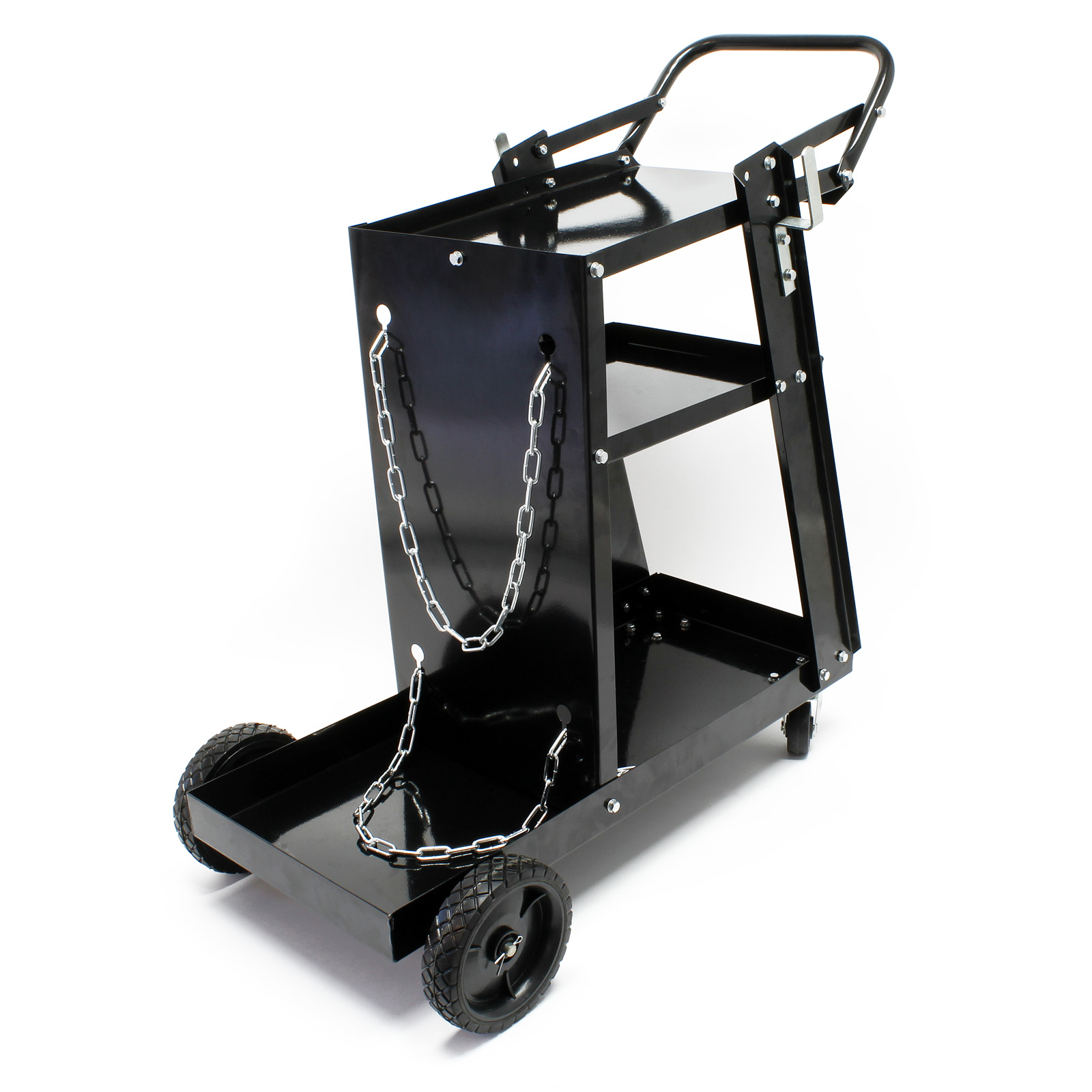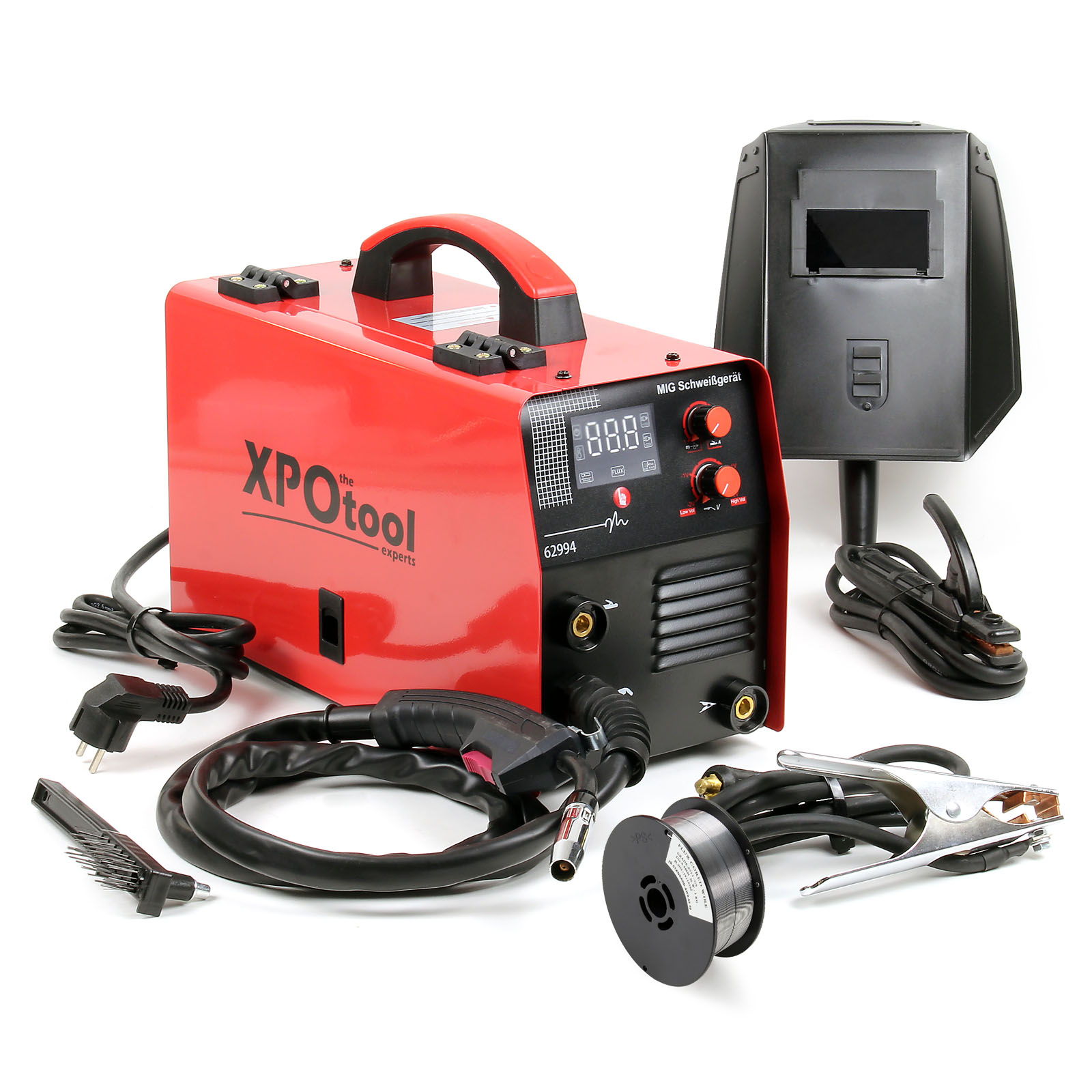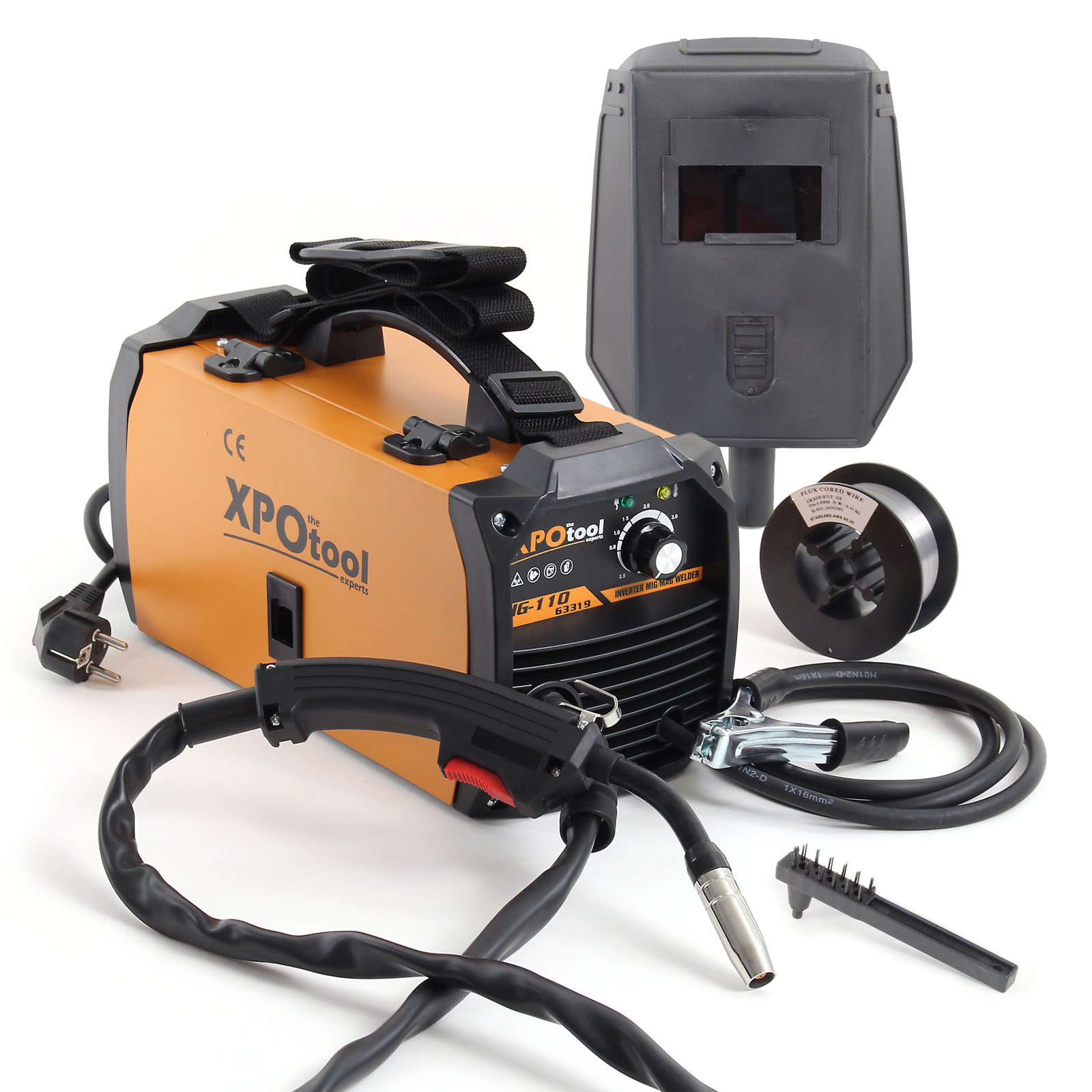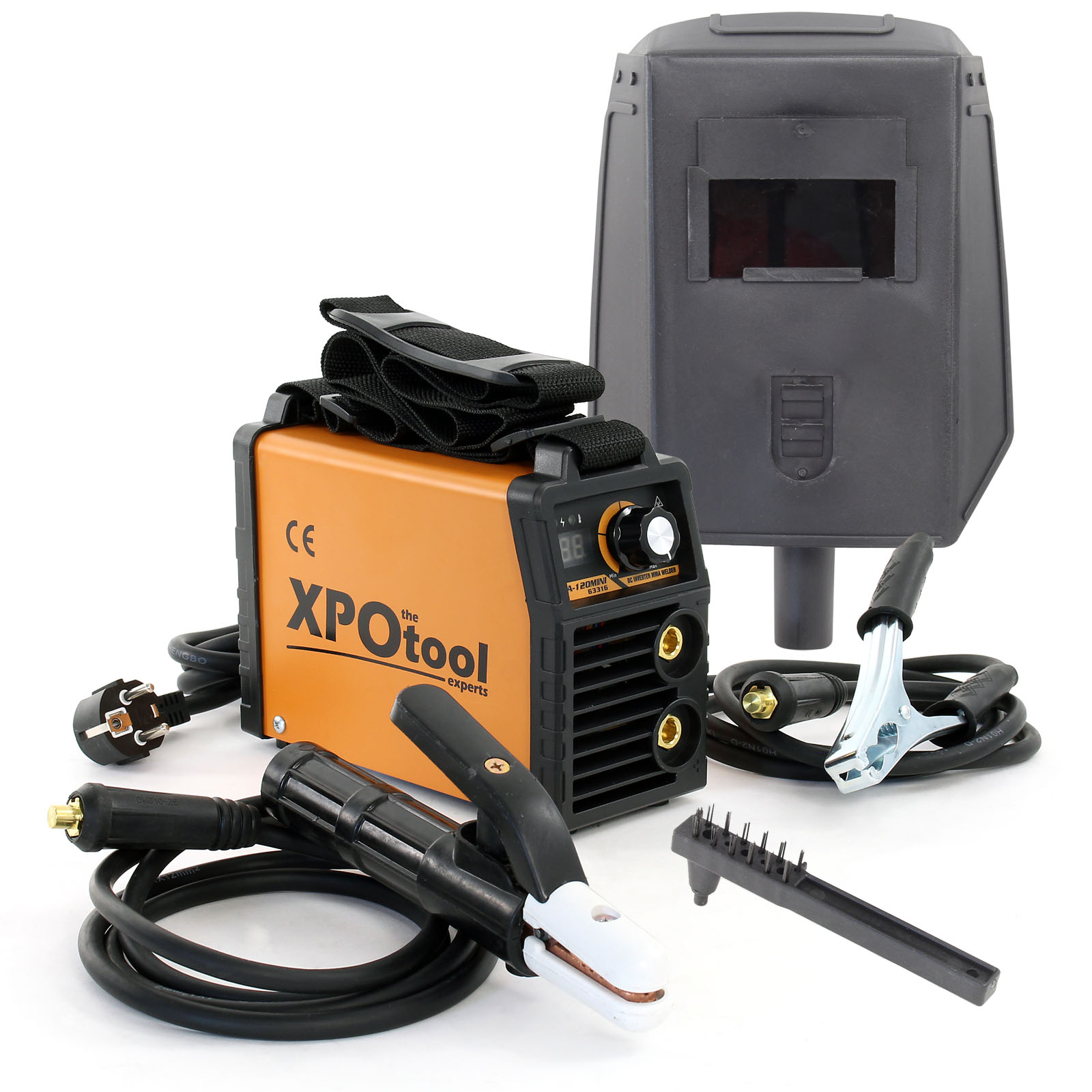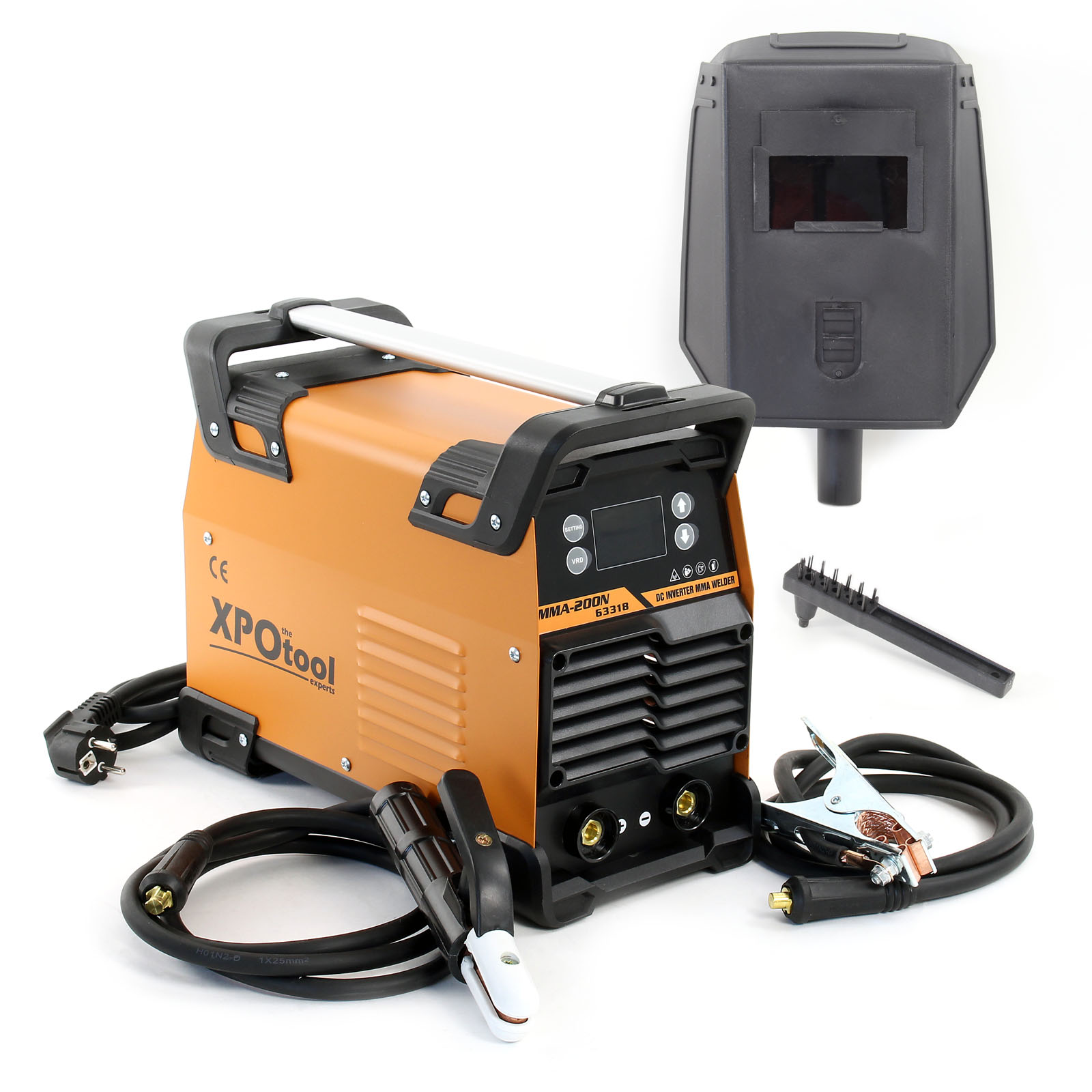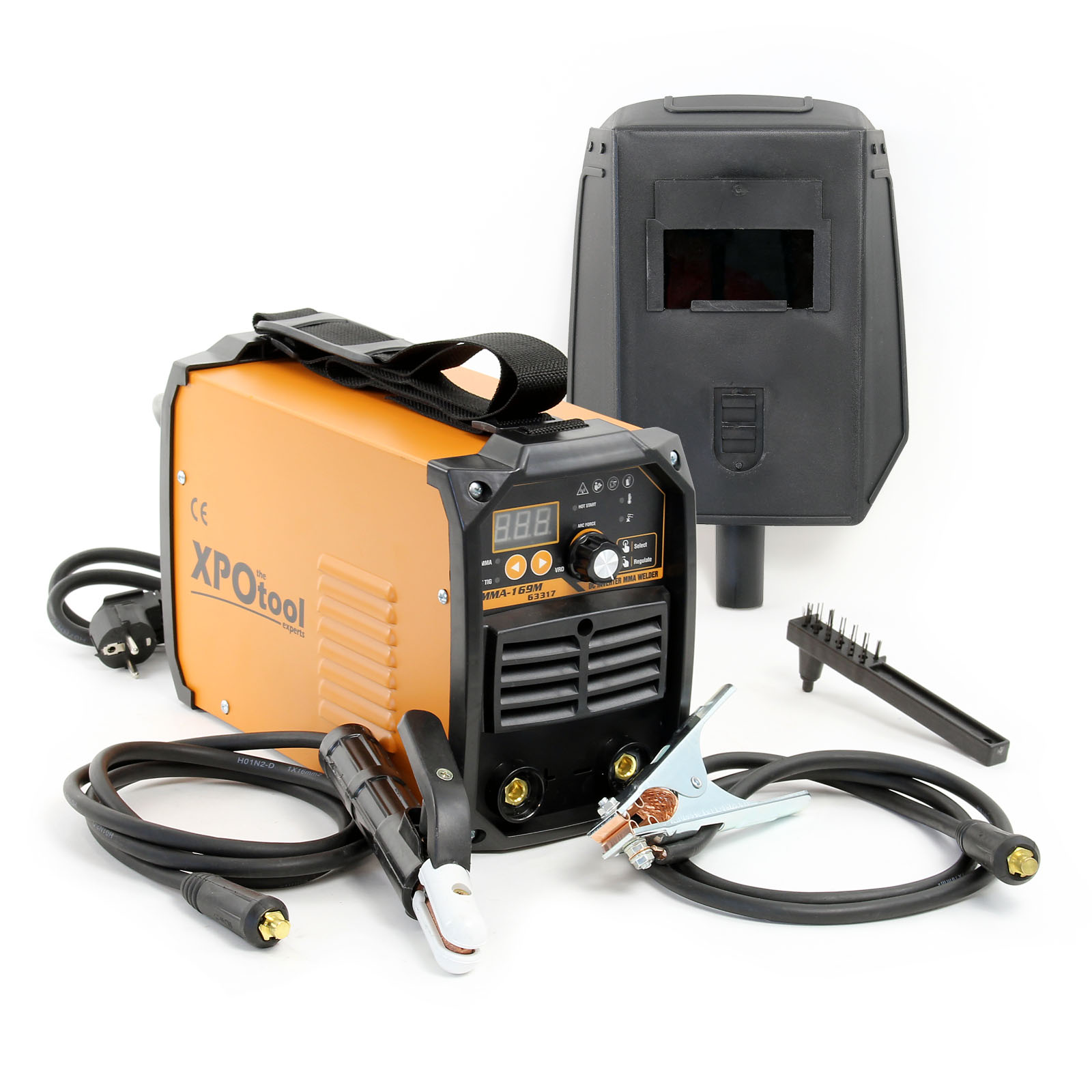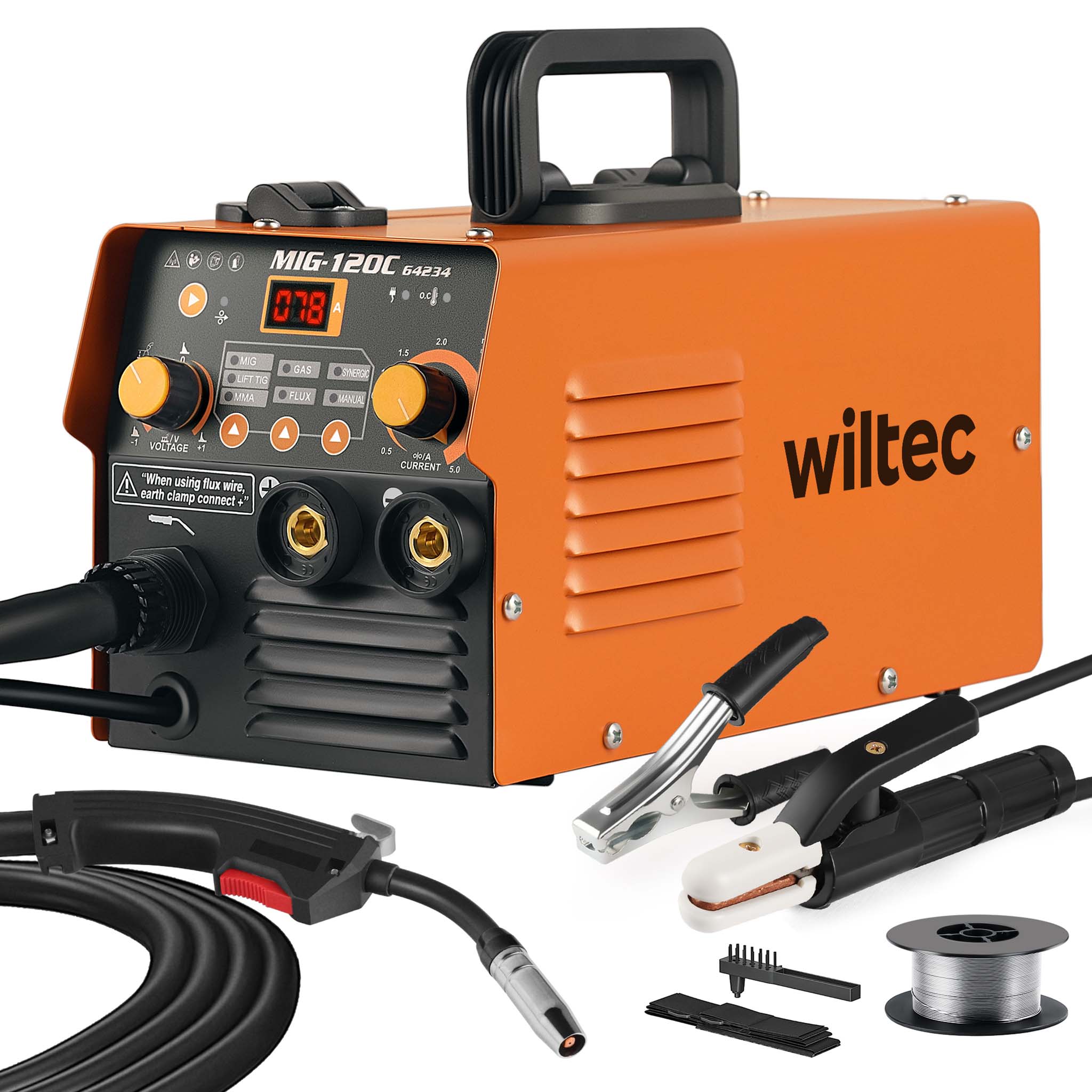Available, delivery time: 2 - 3 days
• 2000 watts
• Max. 300 ° C
• 7 adapters
• Incl. accessories
Available, delivery time: 2 - 3 days
• Dimensions Shelf Center 40 x 28 cm
• Dimensions Base Tray 70 x 29 cm
• 3 inch Front Caster Wheels / 7.5 inch Rear Wheels
• Max. Load 45 kg
Currently not available
• For welding torches up to 180 amperes
• Incl. tungsten electrode
• With gas nozzles
• 3 clamping sleeves Equipment for TIG welding torch
• For welding torches up to 180 amperes
• Incl. tungsten electrode
• With gas nozzles & clamping sleeves
• Storage bag
Available, delivery time: 2 - 3 days
• Welding current 40-160 amps
• Duty cycle 60 %
• IGBT technology
• Including accessories
Available, delivery time: 2 - 3 days
• Ideal for all-position welding and outdoor-use
• Inverter welder with modern IGBT technology
• Only suitable for self-shielded flux-cored wire
• Equipped with overheat and overload protection
Available, delivery time: 2 - 3 days
• With overheat and overload protection
• Arc-force, Hot-start, and Anti-stick function
• IGBT technology for single-phase operation
• With digital display to monitor the amperage
Available, delivery time: 2 - 3 days
• Adjustable height: 735–860 mm
• Inclination adjustable up to 90°
• Made of steel
• Foldable and easy to stow away
Available, delivery time: 2 - 3 days
• With overheat and overload protection
• Arc-force, Hot-start, and Anti-stick function
• IGBT technology for single-phase operation
• With display for setting the parameters
Available, delivery time: 2 - 3 days
• With overheat and overload protection
• Arc-force, Hot-start, and Anti-stick function
• IGBT technology for single-phase operation
• With digital display to monitor the amperage
Available, delivery time: 2 - 3 days
• Electrode, inert gas, and flux-cored self-shielded arc welding
• Including display for adjusting the parameters
• Modern and reliable IGBT technology
• Low weight, equipped with carrying handle
Discover the Versatility and Efficiency of Welding Machines
Welding machines are essential tools in various industries, enabling the fusion of metals to create strong, durable structures. Whether you're a professional welder or a DIY enthusiast, choosing the right welding machine is crucial for optimal results. Our selection includes MIG, TIG, and arc welding equipment, each designed to meet diverse welding needs.
MIG welding machines are known for their ease of use and efficiency. They use a continuous wire feed and shielding gas to produce clean, precise welds, making them ideal for beginners and experienced welders alike. These machines can handle a variety of materials, including steel, aluminum, and stainless steel.
TIG welding machines provide high precision and control, perfect for detailed and delicate welding tasks. Using a non-consumable tungsten electrode, TIG welders are excellent for welding thin materials and achieving high-quality welds. They are widely used in industries that demand exacting standards, such as aerospace and automotive sectors.
Arc welding machines, including stick welders, are robust and versatile, suitable for welding thicker materials in both indoor and outdoor settings. These machines use a consumable electrode coated in flux, which produces a shielding gas, making them ideal for portable and flexible welding applications.
Our welding machines feature advanced technologies, such as IGBT inverters, to enhance performance and efficiency. These innovations ensure stable arcs, reduced energy consumption, and precise control over welding parameters, providing reliable tools for any project.
Explore our range to find the perfect welding machine for your needs and experience the versatility and efficiency that set our products apart.

Does an inverter mig welder need gas?
An inverter MIG welder can be used with or without gas, depending on the type of welding wire and the specific welding application. When using solid wire, an external shielding gas, such as argon or a mix of argon and carbon dioxide, is required to protect the weld pool from atmospheric contamination. This setup is commonly referred to as Gas Metal Arc Welding (GMAW) and is preferred for its ability to produce clean, high-quality welds with minimal spatter, making it ideal for indoor and controlled environments.
On the other hand, if you use flux-cored wire, the inverter MIG welder does not need an external gas supply. This type of wire contains a flux core that generates shielding gases when the wire melts, protecting the weld pool from contamination. This method, known as Flux-Cored Arc Welding (FCAW), is particularly useful for outdoor applications or in windy conditions where external shielding gas might be blown away. Additionally, gasless MIG welding with flux-cored wire is often more convenient and portable, as it eliminates the need for carrying gas cylinders. Thus, an inverter MIG welder offers flexibility to work with both gas-shielded and gasless welding processes based on the project requirements.
Among the most popular are MIG welding machines, known for their ease of use and versatility. They are ideal for welding both thin and thick materials, making them suitable for a broad range of projects. Small welding machines are perfect for hobbyists and small-scale projects, offering portability without compromising performance.
For those seeking the best welding machines, our selection includes top-of-the-line models equipped with advanced features. Welding machines for sale in our store are sourced from reputable manufacturers, ensuring quality and reliability.
Arc welding equipment, including arc welders and stick welders, is another essential category. These machines are highly effective for heavy-duty welding tasks, providing strong, deep welds. TIG welding equipment is favored for its precision and control, making it ideal for intricate welding jobs.
Spot welding equipment and laser welding machines are specialized tools for specific welding applications. Laser welding machines offer high precision and speed, while spot welding equipment is perfect for joining thin metal sheets.
Applications of Welding Machines
Welding machines are indispensable tools used across multiple industries, including construction, automotive, and manufacturing. In construction, they play a vital role in assembling steel structures, bridges, and pipelines, ensuring the stability and longevity of these essential infrastructures. Welding is also crucial in the erection of buildings, where strong and durable joints are paramount.
The automotive industry heavily relies on welding machines for fabricating and assembling car bodies, frames, and other essential components. Advanced welding techniques contribute to the safety, performance, and efficiency of vehicles. From manufacturing to repair, welding machines help maintain the integrity of automotive structures, ensuring vehicles remain roadworthy and safe.
In the manufacturing sector, welding equipment is utilized to produce a wide range of machinery, tools, and consumer goods. Precision welding is essential for creating complex components and assemblies, contributing to high standards of quality and performance. Additionally, welding machines are crucial in repair and maintenance operations, providing quick and efficient solutions for extending the lifespan of metal structures and equipment. This versatility makes welding machines indispensable for maintaining the functionality and safety of various items across industries, supporting the growth and sustainability of our modern world.
XPOtool MIG100 FCAW Welder for Gasless Flux Cored Arc Welding 30-100A IGBT Inverter Welding Machine
The XPOtool MIG100 FCAW Welder is perfect for gasless flux-cored arc welding, offering a welding range of 30-100A. Featuring IGBT inverter technology, it ensures efficient power usage and a stable welding arc. This welder is ideal for hobbyists and DIY experts due to its ease of use and portability.
Operating without shielding gases, it uses a tubular wire electrode with a flux core, eliminating the need for an additional gas bottle. The self-shielded flux-cored wire provides shielding gases to protect the weld pool. The continuous wire feeder supports electrode wire thicknesses of 0.8-0.9 mm, and the rotary control allows easy adjustment of the welding current.
Suitable for most structural steels, carbon and stainless steels, and cast iron, this welder excels in joining thicker materials. Its compact design, carrying strap, and built-in safety features like overheat and overload protection make it a reliable choice for various welding tasks.
What’s Better: Gas or Gasless MIG Welder?
Choosing between a gas or gasless MIG welder depends on the specific requirements of your project. Gas MIG welders, which use a shielding gas to protect the weld pool from contaminants, provide cleaner welds with less spatter. This makes them ideal for indoor environments and applications that require high precision and aesthetic quality, such as automotive work and fine metal fabrication. The shielding gas, typically a mix of argon and CO2, ensures a stable arc and smooth weld bead, which is crucial for detailed work.
On the other hand, gasless MIG welders, which use flux-cored wire, are more convenient for outdoor use and easier to transport and set up. They are particularly useful for welding thicker materials and in situations where shielding gas might be blown away by the wind, such as on construction sites or in exposed outdoor environments. The flux core in the wire produces its own shielding gas when heated, protecting the weld pool and ensuring strong, reliable welds even in windy conditions.
Ultimately, the choice between gas and gasless MIG welders comes down to the specific needs of your project. If you prioritize cleaner welds and work primarily indoors, a gas MIG welder is the better option. However, if you need portability, ease of use, and the ability to weld outdoors without worrying about wind interference, a gasless MIG welder is the way to go. Each type has its own advantages, so consider your working conditions and project requirements when making your decision.

Differences Between MIG Welder and Inverter MIG Welder
MIG welders and inverter MIG welders differ primarily in their power sources and efficiency. Traditional MIG welders use transformers to convert electrical power from high voltage to low voltage suitable for welding. This technology, while reliable, results in bulkier and heavier machines. The transformer-based design also means these welders can be less energy-efficient and offer limited control over the welding process.
In contrast, inverter MIG welders utilize advanced electronic components to achieve power conversion. This results in significantly lighter and more portable machines, making them easier to transport and maneuver in various work environments. The compact design of inverter welders is a considerable advantage for those working in tight spaces or needing to move their equipment frequently.
One of the key benefits of inverter MIG welders is their energy efficiency. They typically consume less power than traditional MIG welders, leading to reduced operational costs. Additionally, inverter technology provides more precise control over the welding parameters, such as current and voltage. This precision enhances the quality of the welds, offering smoother and cleaner results, and allows for better handling of different materials and thicknesses.
Furthermore, inverter MIG welders often come with advanced features such as digital displays, programmable settings, and enhanced arc stability. These features contribute to a more user-friendly experience and improved weld consistency, making them an attractive option for both professional welders and hobbyists seeking high-quality results.
Overall, while traditional MIG welders are robust and reliable, inverter MIG welders offer significant advantages in terms of portability, energy efficiency, and control. Your choice between the two will depend on your specific welding needs, workspace constraints, and preference for advanced features.
Welding Safety: Essential Guidelines and Equipment
Welding is a task that involves significant risks, so adhering to proper safety measures is crucial. Here are some key safety guidelines and necessary equipment to ensure a safe welding environment:
Safety Footwear
Welders should wear safety shoes with steel toes and heat-resistant soles. These shoes protect against heavy objects, sparks, and molten metal that can cause severe foot injuries.
General Safety Equipment
Welders must wear appropriate personal protective equipment (PPE), including:
- Welding helmet with a proper shade filter to protect eyes and face from UV and IR radiation.
- Clear safety glasses or goggles for use during non-welding activities to shield eyes from flying debris.
- Welding gloves made from flame-resistant materials to protect hands from heat and sparks.
- Fire-resistant clothing such as leather jackets, aprons, and welding sleeves to shield the body from sparks and molten metal.
- Hearing protection in noisy environments to prevent hearing damage.
Safety Rules for Specific Welding Types
Spot Welding: Ensure the workspace is dry and free from flammable materials. Spot welders should follow strict electrical safety protocols, including grounding and insulation checks. Always use a spot welder with built-in safety features like emergency stop buttons and guards.
MIG Welding: Follow these precautions:
- Ensure proper ventilation to avoid inhaling fumes.
- Keep flammable materials away from the welding area.
- Regularly inspect welding cables and connections for damage.
- Use a fire extinguisher nearby in case of emergency.
Health and Safety Measures
Spot welding can produce harmful fumes and UV radiation. Welders should use fume extraction systems and wear respiratory protection if necessary. Regular health check-ups can help detect any welding-related health issues early.
Safety Requirements and Precautions for MIG Welding
- Use proper grounding to prevent electrical shocks.
- Maintain equipment to ensure it operates safely.
- Avoid welding in wet or damp conditions to reduce the risk of electric shock.
- Be aware of your surroundings and keep the work area organized to prevent accidents.
By following these guidelines and using the appropriate safety equipment, welders can significantly reduce the risks associated with their work and maintain a safe working environment.

Is a Gasless MIG Welder Better Than a Stick?
Gasless MIG welders are generally easier to use and provide a cleaner finish on thin metals, while stick welders excel in welding thicker materials and can be used in various environmental conditions. The choice depends on the specific requirements of your welding projects.

Can You Use Gasless Wire in a Gas MIG Welder?
Yes, you can use gasless wire in a gas MIG welder. However, ensure to switch the polarity according to the wire manufacturer's instructions for optimal performance.

Does an Inverter MIG Welder Need Gas?
An inverter MIG welder can use both gas and gasless wires. When using gasless wire, no external gas supply is needed, making it versatile for different welding situations.
Discover Our Comprehensive Selection of Welding Machines
Our welding machines offer a diverse range of high-quality equipment tailored to various welding applications, ensuring both professionals and hobbyists find the perfect tool for their needs. From MIG and TIG welders to arc welding equipment, our selection incorporates the latest technology to deliver reliable and efficient performance.
One of our standout products is the XPOtool Inverter Welding Machine MMA MIG Welder. Featuring IGBT technology, this versatile machine supports both MIG and MMA welding with a welding current range of 40-160 amps and a 60% duty cycle, making it ideal for a variety of tasks. It includes all necessary accessories and ensures quick delivery within 2-3 days (Item no.: 62994).
For those looking for a portable option, the XPOtool MIG100 FCAW Welder is perfect for gasless flux-cored arc welding. With a current range of 30-100 amps and advanced IGBT inverter technology, this welder is designed for outdoor use and all-position welding. Its overheat and overload protection make it a reliable choice, available with fast delivery (Item no.: 63319).
Our range also includes the XPOtool Portable MMA Stick Welder, available in various models. The 20-120Amp model (Item no.: 63316) offers features like Arc-force, Hot-start, and Anti-stick functions, and is ideal for lightweight and portable welding tasks. For higher amperage, the 20-200Amp model (Item no.: 63318) provides similar functions with an added display for setting parameters. Additionally, the 20-160Amp model (Item no.: 63317) combines these features with a digital display to monitor the amperage.
The XPOtool Digital IGBT Welding Machine is another versatile option, supporting MIG, MMA, FCAW, and TIG welding for sheets ranging from 1–5 mm. This synergetic, digital inverter machine, equipped with modern IGBT technology and a carrying handle, offers comprehensive functionality (Item no.: 64234).
Whether you're tackling small DIY projects or large industrial tasks, our range of welding machines ensures you have the perfect tool for every job. Explore our collection to find the right equipment that meets your specific welding needs and enjoy the advanced technology and reliable performance that define our products.


